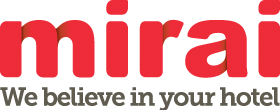En español, en français, em português.
Hotels usually see the positive side of their website conversion rate. The one that lets them know how many of every 100 users end up making a booking. A conversion rate of 4% tells us we get 4 bookings for every 100 users. At Mirai we see it a little differently. Why do 96 of those users leave without making a booking? This is the less positive side, but it’s also where the opportunity for improvement really lies. The thing is, we make a huge effort (lots of work and investment in Ads) to bring those 100 users to our website, but do not achieve our goal with 96 out of 100 people. How can we reduce this number? Mirai Rescue is the result of months of work on this subject.
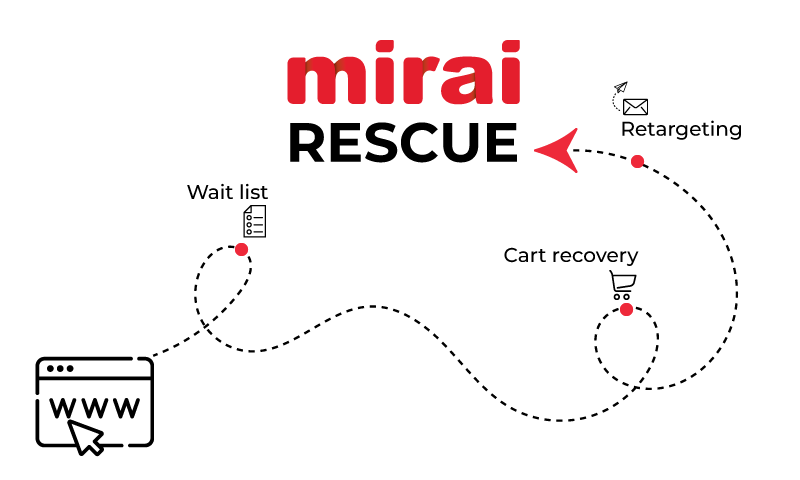 Obviously, we know that many people don’t book because they’re simply not yet ready to book. That’s normal and there’s nothing at all strange about it. They are looking for information, photos, a telephone number or the address. Some of them may even already have a booking and are just doing some research before their trip to the destination. Other visits might come from within the hotel itself, by guests who are staying at the hotel or staff members looking for information. Your website has to respond to all these different kinds of users. If only all of them were visiting to make a booking! But it’s not like that. Depending on the type of hotel, between 15% and 45% of users who visit the website search for room availability and prices. The rest are looking for something else and don’t even choose dates.
Obviously, we know that many people don’t book because they’re simply not yet ready to book. That’s normal and there’s nothing at all strange about it. They are looking for information, photos, a telephone number or the address. Some of them may even already have a booking and are just doing some research before their trip to the destination. Other visits might come from within the hotel itself, by guests who are staying at the hotel or staff members looking for information. Your website has to respond to all these different kinds of users. If only all of them were visiting to make a booking! But it’s not like that. Depending on the type of hotel, between 15% and 45% of users who visit the website search for room availability and prices. The rest are looking for something else and don’t even choose dates.
However, once a user searches for availability and prices, your work on your conversion rate really begins. Now you don’t have any excuses. You have a “qualified” user who is interested in your hotel and it’s within your power to generate a booking.
Mirai Rescue
There are dozens of reasons why users start the booking process but don’t finish it. Some examples are:
- They’re just researching and still haven’t made a decision about travel.
- The price doesn’t fit with their budget.
- They have seen a better price on an OTA.
- The price fits, but after viewing the location or hotel reviews, they decide not to continue.
- They have to talk about it with their partner, family or friends.
- They are interested, but don’t have the time right now and are thinking about booking later.
- The hotel is fully booked or has restrictions like minimum stay requirements.
The vast majority of hotels accept this loss of a potential customer with frustration. Following up with every user who doesn’t book is just not viable. That’s why we have developed Mirai Rescue, a module designed to automatically respond to potential abandonment by users, to keep them on the website or make sure they come back to finish their booking. We have to emphasize that this is an automatic system, meaning you don’t have to do a thing. Just watch your direct sales grow without lifting a finger.
A strategy for each abandonment page
No hotel is the same and online, offline and direct sales strategies can be very different. There are hotels that always have rooms available and others that have problems in high season because they run out of available rooms very quickly. There are hotels that have better prices on their website (a strategy that Mirai fully supports) and others that have lots of price disparities. Booking a room in a city hotel for two nights is not the same as booking ten days on the beach for a family of five.
On the other hand, every website user for every hotel has to go through the same booking process when making a reservation. Mirai Rescue offers specific functionality for each potential abandonment of the process: Wait List, Cart Recovery and Retargeting.
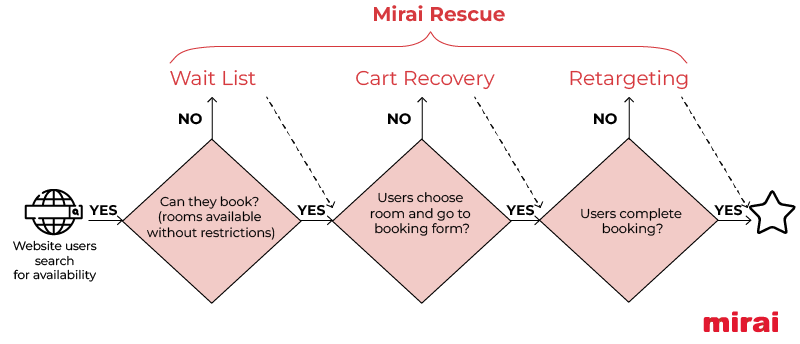 Wait List
Wait List
Let’s look at the worst-case scenario. Your user can’t book because there are no rooms available, or the available rooms have restrictions that prevent them from booking. If we detect this, in addition to the existing options to show alternative dates or other available hotels within the group, the booking engine will offer the user a simple form to join a waiting list, which will also include the dates they have chosen and the number of people.

And then we get to work. Mirai will review those dates every three hours (you won’t have to do a thing), and as soon as we detect availability, we’ll send an email to the user inviting them to finish their reservation.
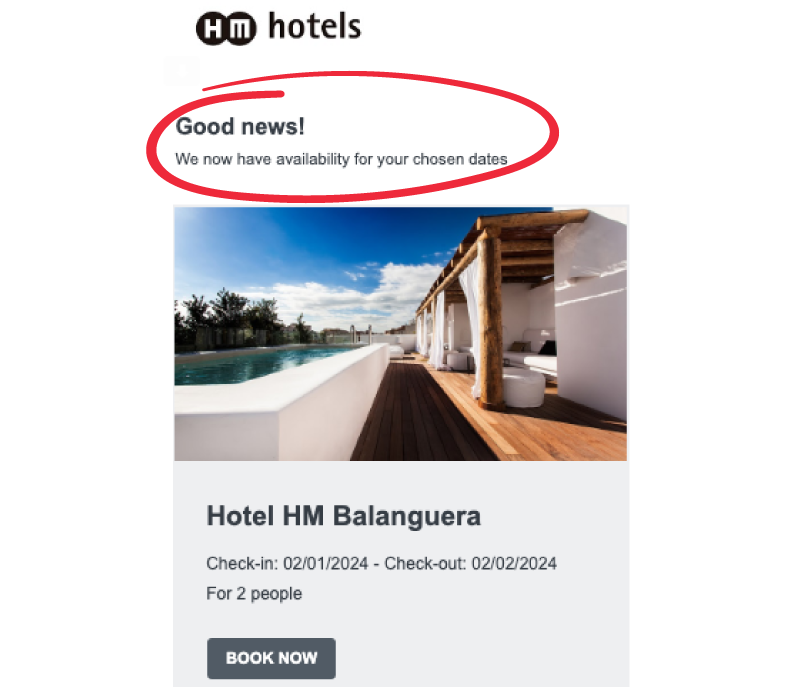
When is the waiting list useful?
In a lot of cases! It can also be said that almost all of them generate incremental sales, as they are users who would almost certainly have booked another hotel because they couldn’t book yours. That means you’re “stealing” or “recovering” (depending on how you look at it) another hotel’s sale and making it yours.
- The hotel is fully booked, but some last minute cancellations arrive, especially from Booking.com, and these cancellations automatically open up room availability for you. Your users will become the first to know about that last available room, increasing your chances of selling it direct instead of through the OTAs.
- If your channel manager cannot access the actual inventory of your hotel, there are times when you’ll be closed for sales, even when there is inventory awaiting review to reopen rooms. Once you do so, you’ll notify your customers who have enrolled in the waiting list.
- You started with strong sales restrictions and have been relaxing them little by little. As you relax them, your registered users will receive a message telling them that they can now book.
- Many users book your hotel for next year as soon as they get back from their holiday, especially in resort hotels. In some cases, you may not yet have uploaded rates for the following year, so they can’t book. As soon as you load rates, they will immediately receive a message so they can complete their booking.
As you can imagine, the conversion rate for these emails is really high (7.5% on average) as they are users who are very interested in your product.
Cart Recovery
Even if you have availability loaded, many users abandon on the first step of the booking process after just looking at rooms, photos and prices. In fact, around 18% of users on average move forward, with the percentage ranging between 11% to 25%. Many of the reasons are similar to those mentioned above, such as prices that don’t fit with their budget, pricing disparities with OTAs or simply a lack of time.
For pricing disparities with OTAs, our price comparison module includes a “price match” option, which allows you to adjust your price when an OTA (the ones that you decide) has a price disparity.
But above and beyond the price comparison, we now present our Cart Recovery system as your ally in these circumstances. If we detect inactivity for X seconds or that the user is about to close the window, we will offer them an option to save their search, so we can send it to them by email and they can continue their reservation later.
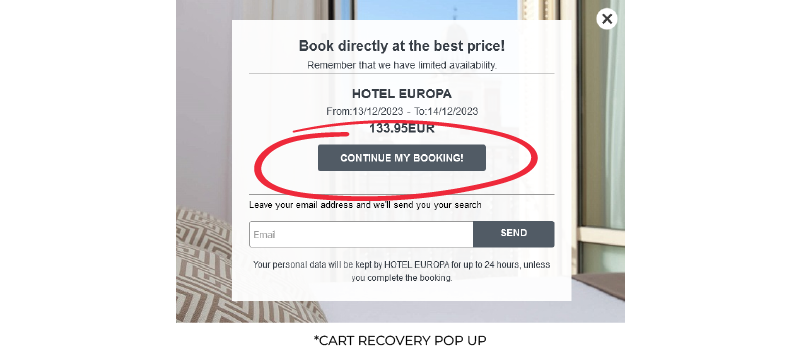
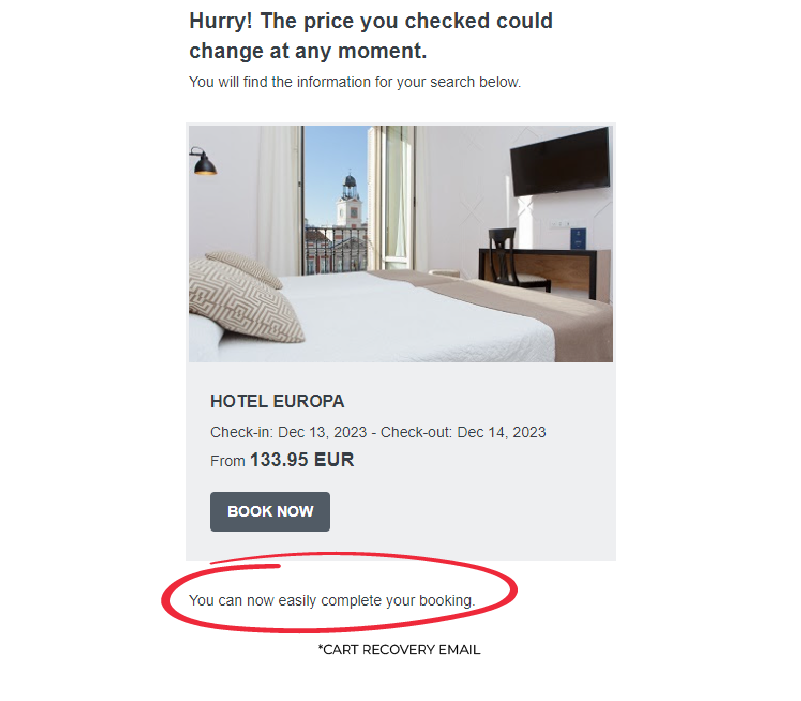 Cart Recovery also has high conversion rates (on average 6.8%) as it is used by customers interested in continuing their booking later. This way you make sure that “later” doesn’t end up being in another hotel or in the clutches of an OTA.
Cart Recovery also has high conversion rates (on average 6.8%) as it is used by customers interested in continuing their booking later. This way you make sure that “later” doesn’t end up being in another hotel or in the clutches of an OTA.
Another great feature of the Mirai booking engine beyond Mirai Rescue is the messaging module that allows you to totally personalize your messages to each user, based on the dates of the stay, nationality, reservation cost, lead time or any other variable you can imagine.
Retargeting
There is still one more hurdle to overcome for users who reach the booking form: to fill in their personal details and pay. Our data shows that an average of 20% complete the booking from here, with the numbers ranging from 9% to 41%. Although it seems strange to some people, many of us hesitate on this page, especially if the price is high. People doubt whether it’s the right hotel, a good price or whether they should check it with their partner. Others might not have their credit card with them or just don’t want to use it because they’re walking or on the bus.
For those who have doubts, we offer a retargeting option. If we detect that users leave the form half completed but have not yet booked, we will automatically send them an email to follow up on their booking and persuade them to continue when they are ready.
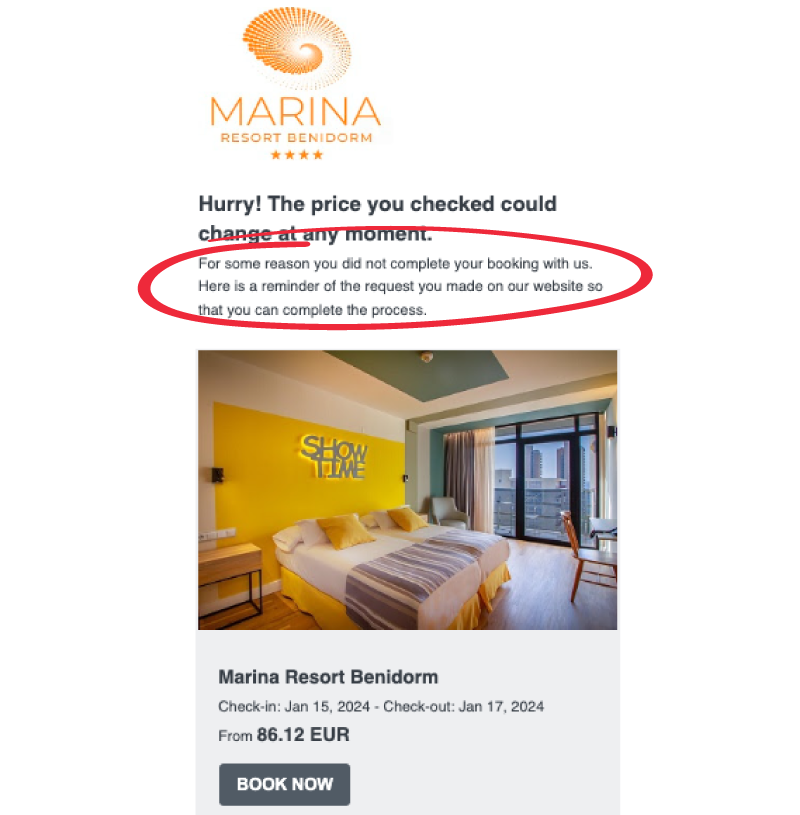
These users are definitely interested in booking as they are the ones who have gone furthest in the process, making the conversion rate of these emails very high, also with an average of 7%.
Recover 1.71% of lost sales
After months measuring the impact of Mirai Rescue on our clients, the numbers are as follows: 1.71% of recovered sales, in most cases incremental sales for your website. Some hotels experience a 3% increase in this number, which constitutes a substantial boost in their total production that would have been lost otherwise.
1.71% may not sound like much, but what can you do to increase your ADR by almost 2% without lifting a finger? Or don’t you want to lower your direct sales cost? Well, here’s something that automatically lowers your commission payments by 1.71%. And by the way, this incremental sale is very similar to the one generated by another of the great features of our booking engine: the automatic upselling system.
Check your own numbers in our BI system
We measure everything we do at Mirai and make it available to you through our Business Intelligence or BI system. The “Mirai Rescue” menu allows you to see the numbers for your hotel or your entire chain for reservations, roomnights, revenue and percentage of your total sales.

You don’t have to do a thing, Mirai Rescue is active in your hotel by default and it’s also free
As it’s mostly incremental sales (and who doesn’t want more sales?) and has no cost for you, we’ve activated the Mirai Rescue module for all our clients (with the exception of those with similar systems already in place).
By default, the email we send to customers features a generic photo and your hotel’s logo is not included. If you wish to customize these elements with your photo and logo, or if you need more information about Mirai Rescue, get in touch with your account manager who will provide you with all the details.



